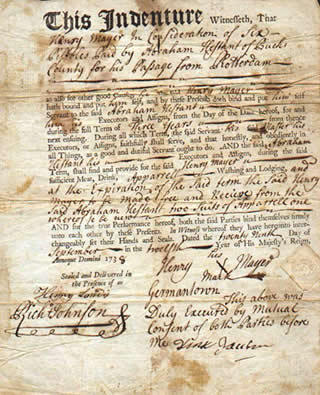
Indentured servitude
Indentured servitude is a form of labor in which a person is contracted to work without salary for a specific number of years. The contract, called an "indenture", may be entered voluntarily for purported eventual compensation or debt repayment, or imposed involuntarily as a judicial punishment. The practice has been compared to the similar institution of slavery, although there are differences.
Historically, in an apprenticeship, an apprentice worked with no pay for a master tradesman to learn a trade (this was often for a fixed length of time, usually seven years or less). Apprenticeship was not the same as indentureship, although many apprentices were tricked into falling into debt and thus having to indenture themselves for years more to pay off such sums.
Like any loan, an indenture could be sold. Most masters had to depend on middlemen or ships masters to recruit and transport the workers, so indentureships were commonly sold by such men to planters or others upon the ships arrival. Like slaves, their price went up or down, depending on supply and demand. When the indenture (loan) was paid off, the worker was free but not always in good health or of sound body. Sometimes they might be given a plot of land or a small sum to buy it, but the land was usually poor.
Africa[edit]
A significant number of construction projects in British East Africa and South Africa, required vast quantities of labor, exceeding the availability or willingness of local tribesmen. Indentured Indians from India were imported, for such projects as the Uganda Railway, as farm labor, and as miners. They and their descendants formed a significant portion of the population and economy of Kenya and Uganda, although not without engendering resentment from others. Idi Amin's expulsion of the "Asians" from Uganda in 1972 was an expulsion of Indo-Africans.[52]
The majority of the population of Mauritius are descendants of Indian indentured labourers brought in between 1834 and 1921. Initially brought to work the sugar estates following the abolition of slavery in the British Empire an estimated half a million indentured laborers were present on the island during this period. Aapravasi Ghat, in the bay at Port Louis and now a UNESCO site, was the first British colony to serve as a major reception centre for indentured Indians from India who came to work on plantations following the abolition of slavery.[53]
Legal status[edit]
The Universal Declaration of Human Rights (adopted by the United Nations General Assembly in 1948) declares in Article 4 "No one shall be held in slavery or servitude; slavery and the slave trade shall be prohibited in all their forms".[54] More specifically, it is dealt with by article 1(a) of the United Nations 1956 Supplementary Convention on the Abolition of Slavery.
However, only national legislation can establish the unlawfulness of indentured labor in a specific jurisdiction. In the United States, the Victims of Trafficking and Violence Protection Act (VTVPA) of 2000 extended servitude to cover peonage as well as Involuntary Servitude.[55]